Raspberry Pi 3 Windows 10 Iot Core Review 2017
To wrap up the "New year, New Dev" blog serial, we'll become into using Windows x IoT Core and show how piece of cake it is to starting time developing applications to deploy on IoT devices such as the Raspberry Pi 3. If you oasis't had a chance to read the start ii posts in this serial, y'all tin find them here:
- New Year, New Dev: Sharpen your C# Skills
- New year's day, New Dev: Developing your idea into a UWP app
Let'southward begin by explaining what Windows ten IoT Core really is.
Windows 10 IoT Core is a version of Windows 10 that is optimized to run on smaller IoT devices, with or without a brandish, that allows you to build apps using the rich Universal Windows Platform (UWP). In fact, one of the goals for UWP was to enable the same application to run on PC, Xbox, HoloLens, Surface Hub or IoT Cadre devices. This enables you, as the developer, to create a core awarding with custom, adaptive user experiences appropriate for these devices.
In UWP at that place are extension APIs available to do things that are specific to your platform or device. For example, there are extension SDKs that give you access to unique features in Windows Mobile and on Surface Hubs. The extension SDKs for Windows IoT give yous access to the APIs that can manage things like lights, sensors, motors, buses and much more.
Windows IoT Core supports a broad range of devices. Here are some examples:
- Raspberry Pi 2
- Raspberry Pi three
- Arrow DragonBoard 410c
- MinnowBoard MAX
- Intel Joule
Out of the box, you lot can employ the UWP programming linguistic communication you're most comfortable with to build apps for IoT Cadre; these languages back up both apps with or without a User Interface (aka "groundwork applications") and are shipped with Visual Studio by default.
- C#
- C++
- JavaScript
- Visual Basic
Alternatively, you tin can use one of the following IoT-focused languages; these languages can simply be Groundwork Applications.
- C/C++ with Arduino wiring
- js
- Python
To use one of the "IoT focused" languages, you'll need to install the Windows IoT Core Projection Templates Visual Studio Extension. Y'all tin can download these correct from Visual Studio past going to Tools > Extensions and Updates. Or, yous can install information technology separately past downloading it (get here for VS2015 or here for VS 2017).
For the purposes of today'southward post, we will show how to install Windows 10 IoT on a device, how to install the tools you'll need, and share several sample applications to get y'all started.
Getting started
The IoT Core team has made information technology very piece of cake to get started by providing a flow-based Become Started page on the Windows IoT Core web page. Allow me accept you through the steps:
Stride ane:
Go to the Get Started folio here and you'll be greeted with Step 1: Select Your Hardware. Cull the device you're using, for this post, I'll choice Raspberry Pi 3:
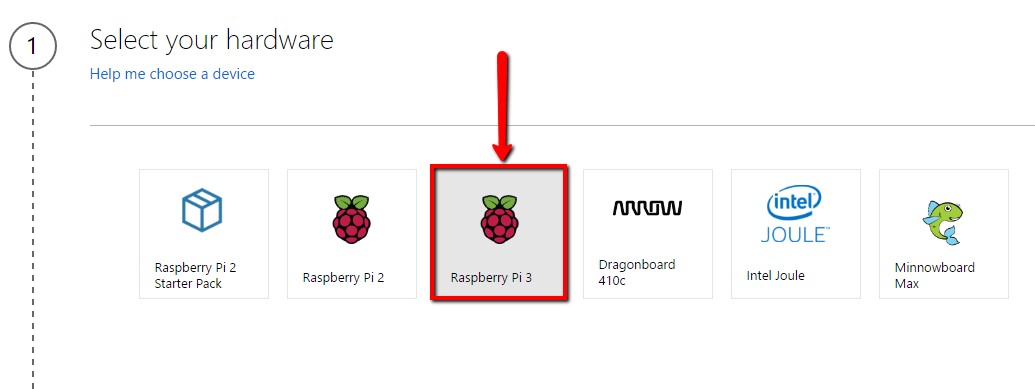
Stride 2:
Select the route you want to install Windows x IoT Core. The almost mutual choice is to install it directly to a blank microSD Card:
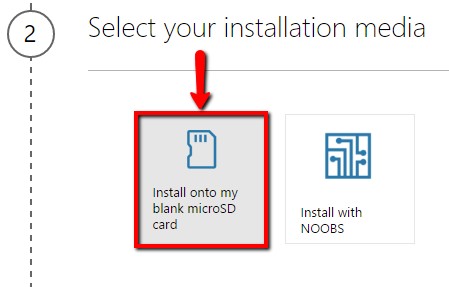
Step iii:
Next, you'll go to pick what version of Windows 10 IoT Core you want to employ.
Important Note: Normally, you'd choose the not-insider version. Only choose the Insider Preview if you have the Insider Preview UWP SDK installed in Visual Studio 2017. The SDK version has to lucifer the Os version on the device in club to deploy to information technology.

Step four:
You're washed! Now click the Next button to navigate to the next phase of the setup procedure, getting the tools.
Installing the tools
During this phase of Getting Started, you'll get through four high level steps. At the last step, y'all'll be running an application on your IoT device! Here are the steps:
- Get the Tools
- Set upward your device
- Gear up Visual Studio
- Write your starting time app
ane – Become the Tools
In this step, you'll download and install an amazing tool, the Windows 10 IoT Core Dashboard (approx. 54MB). This tool has a lot of features that makes using Windows 10 IoT core much easier than it has e'er been. One time you've installed information technology, detect it in your Showtime Menu'south apps list or search for "IoT Dashboard."
You should now encounter a Showtime folio like the following:
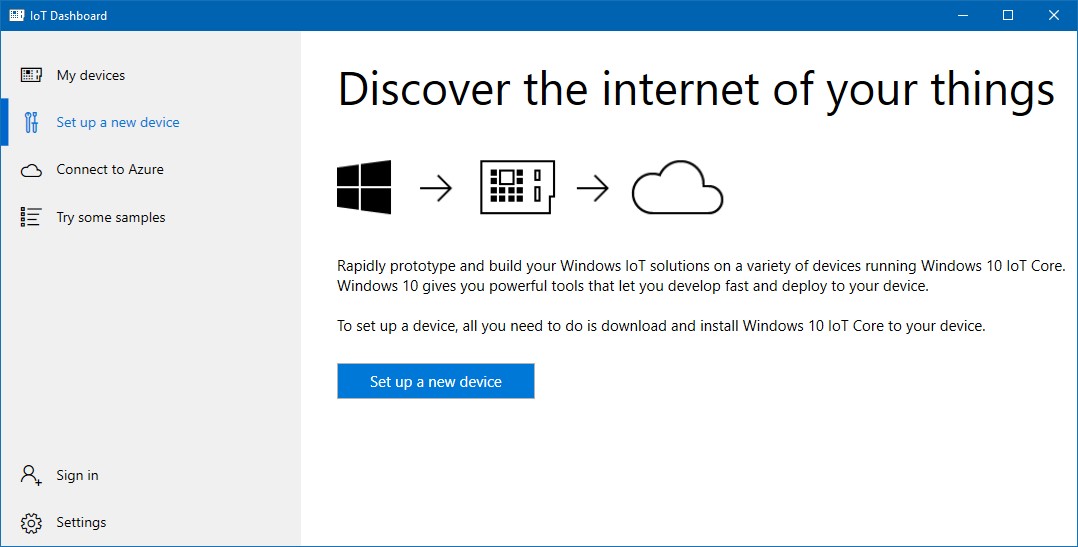
2 – Set upwardly your device
With the Dashboard running, y'all tin at present set your device by clicking the "Set up a new device" button. This makes the installation process very easy, but a few selections and a click of the button.
Here's a screenshot of the "Set up a new device" page. Take note of the version of Windows IoT Core you're installing. The current version is 14393, otherwise known equally the Anniversary Update.
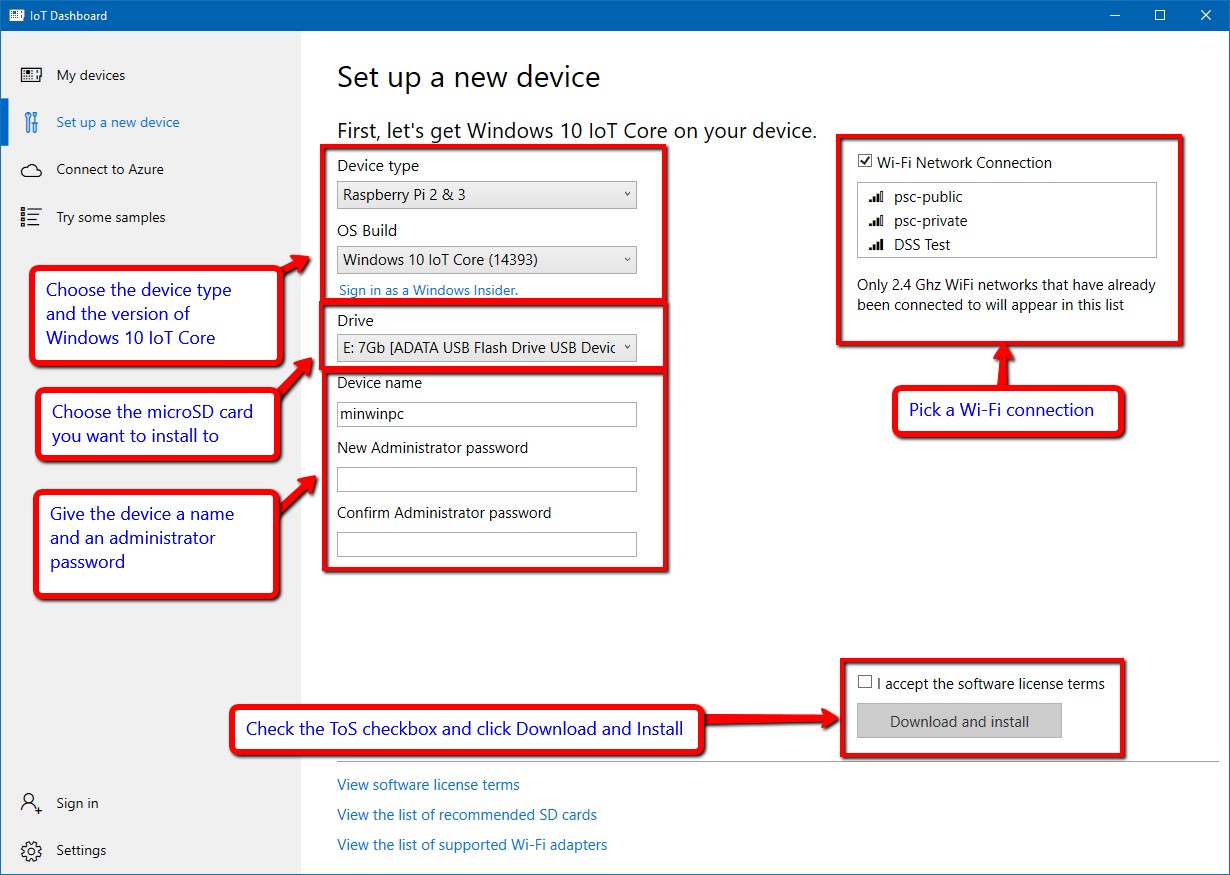
Once this is done, you're adept to get! Merely remove the microSD card from your PC and insert it into the Raspberry Pi and boot information technology up.
Note: The first time boot-upward will take longer than normal because information technology is performing an initial configuration. Be patient and do non ability down during this. If yous accept whatsoever trouble and it doesn't kick, merely repeat the setup again to get a fresh showtime.
3 – Setup Visual Studio
Now let's review what yous have installed for tools.
If you do not have Visual Studio 2017 installed
You tin can download and install Visual Studio 2017 Community edition, for gratis, from hither. This is not a "express" version, the Community edition is a feature-rich version of Visual Studio with all the tools yous need to develop UWP applications and much more.
When running the installer, make sure y'all check off the Windows Platform Apps workload to get the Tools and SDK. Here's what the installer looks similar:
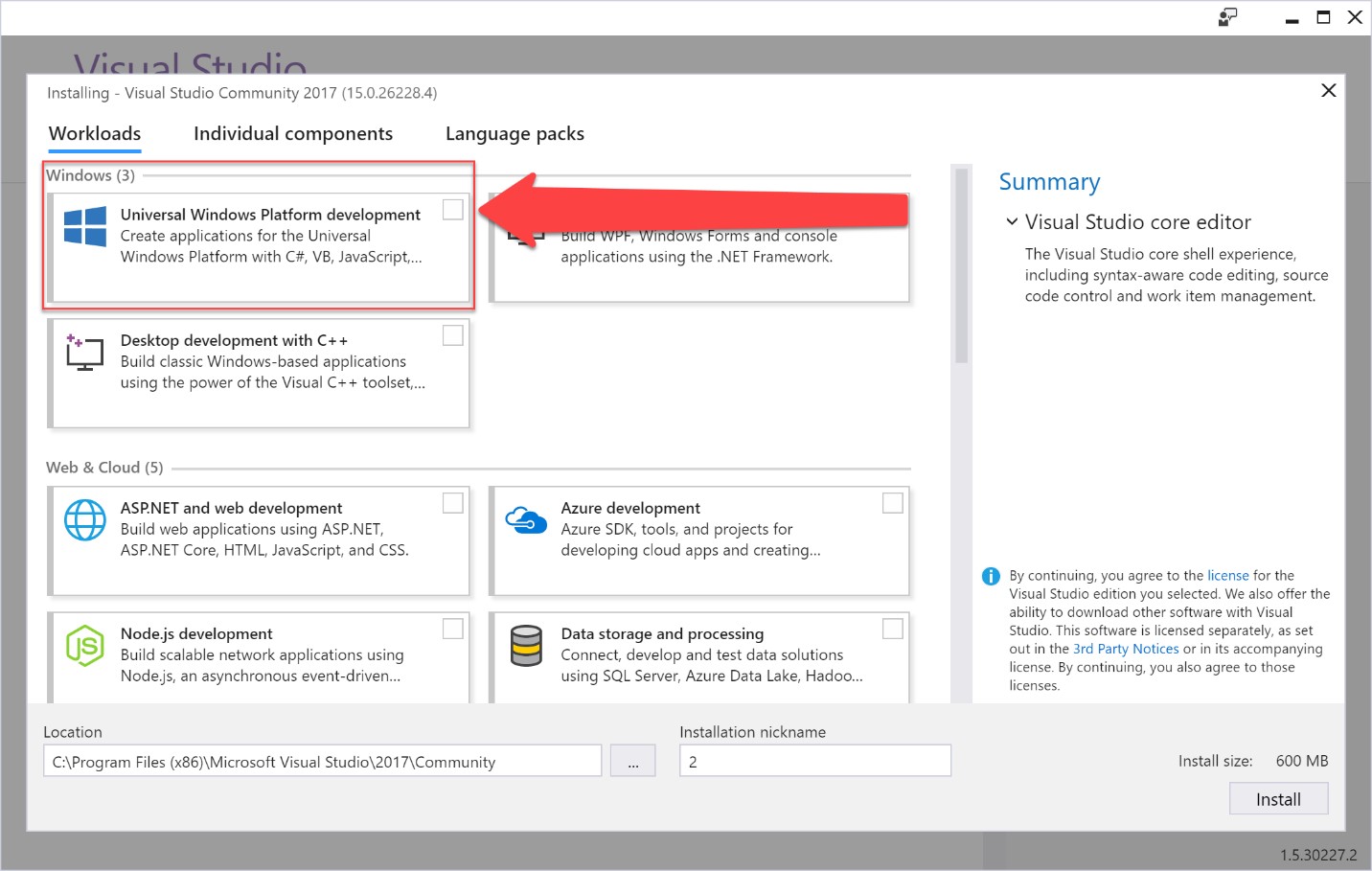
If you already have Visual Studio 2017 installed
If you lot already installed Visual Studio, then let'south check if you accept the UWP tools installed. In Visual Studio, drop down the Help menu and select "About Visual Studio." You'll see a modal window popular out, inside the "Installed Products" are y'all tin scroll downwardly to check for "Visual Studio Tools for Universal Windows Apps":
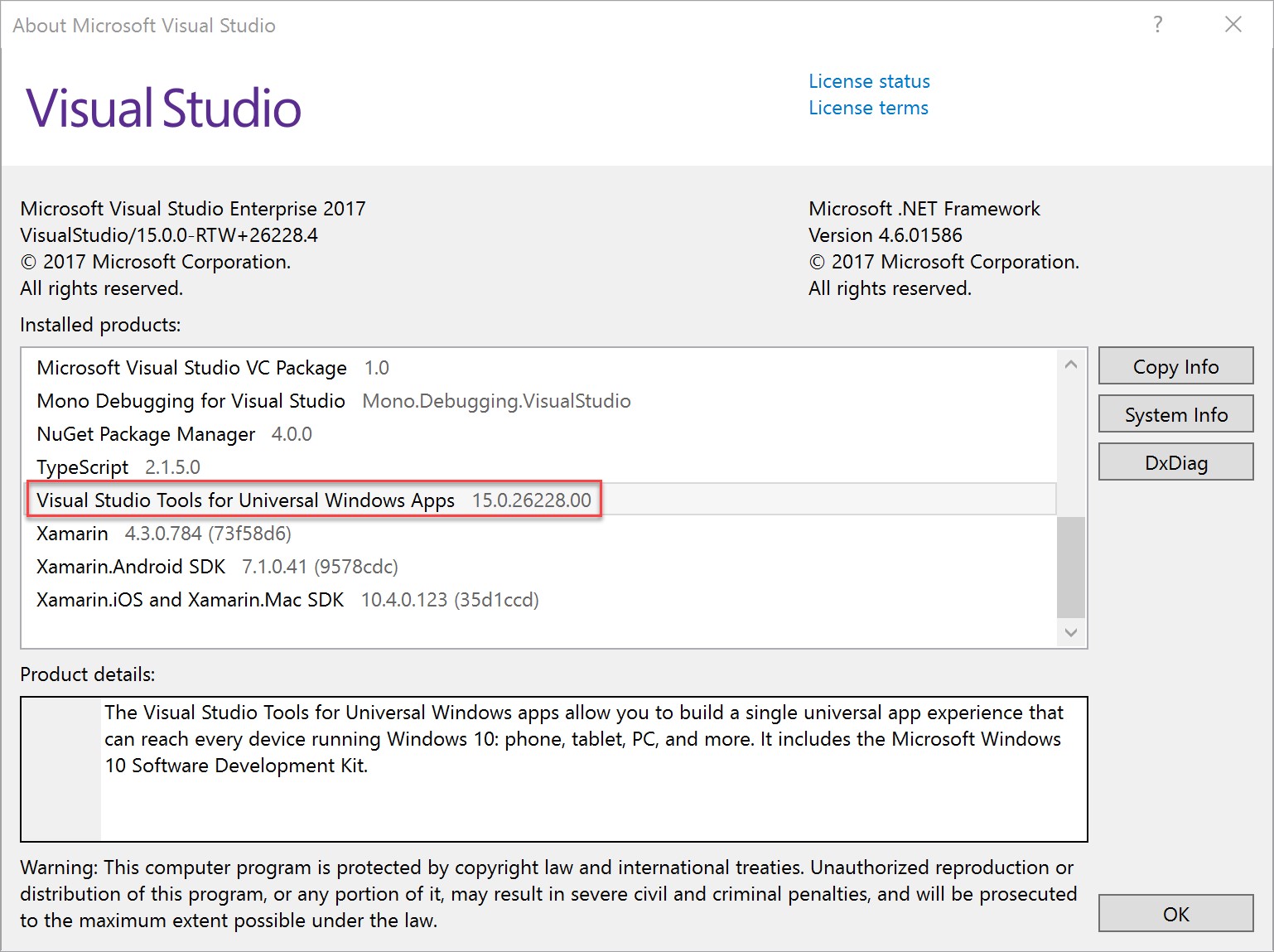
If you exercise not accept them installed, y'all can use the standalone SDK installer to install them (see UWP SDK paragraph beneath) or rerun the Visual Studio 2017 installer and select the "Universal Windows Platform development" workload to install it.
Note: Y'all can use Visual Studio 2015, but make sure you're on Update iii in addition to having the UWP SDK installed.
UWP SDK Version
Now that you lot have Visual Studio 2017 and the UWP tools installed, yous'll want to have the UWP SDK version that matches the Windows 10 IoT Core version yous installed. Every bit I mentioned earlier, the current version is 14393.
If you just installed Visual Studio, this would exist the SDK version y'all take installed already. However, if you do need the 14393 SDK, yous can go the standalone installer from here (notation: if you've take the Windows IoT Core Insider Preview choice, you can go the Insider Preview SDK from hither).
TIP: Install the IoT Core Project templates
At this indicate, you tin build and deploy to an IoT device just considering y'all have the UWP SDK installed. However, you lot tin can get a productivity boost past installing the IoT Core project templates. The templates contain project types such as: Background Awarding, Console Application and Arduino Wiring application. Download and install the templates from here.
Write your showtime app
At this betoken, your device and your developer environment is set upward. Now it's fourth dimension to start writing apps! You may be familiar with the "Hello World" app as being the first application you build when trying a new language or platform. In the world of IoT, these are known as "Hello Blinky" apps.
There are several excellent How-do-you-do Blinky sample applications (when we say headless we mean with no user interface; yous tin can however accept a brandish connected to the system if you wish) to help you become a leap-start:
- C#
- C# Blinky Headless with Total Documentation
- C# Blinky Headless Code Only
- VB Blinky Headless Lawmaking But
- C# Blinky UI App
- C++
- Blinky Headless
- Blinky Headed
- Panel App
- Arduino Wiring Hello Blinky
- js Hello Blinky
There are even more than Microsoft authored samples located at our Windows IoT Dev Eye.
You can also check out what the community has built on websites such every bit Hackster.io where developers open up source their Windows ten IoT Core projects, build specs and source lawmaking. There are hundreds of projects available; a few examples are:
- Facial recognition to open up a door (video)
- Hands on lab IoT Atmospheric condition Station
- Dwelling house Automation with Raspberry Pi 2
- Magic Mirror
There are unlimited possibilities with Window 10 IoT cadre, from dwelling automation to industrial robotics or even environmental monitoring. Your app doesn't have to exist a complex organisation, you tin can build a UWP app to build a smart mirror, turn your hallway lights when motility is sensed, or use a light sensor to open up your shades at dawn and close them at dusk! We wait forward to seeing what you build with Windows 10 IoT Core; transport us a tweet @WindowsDev and share your creations with us!
Resources
- Windows IoT Dev Middle
- IoT core Documentation (aggrandize the sections on the left for a lot more)
- Short class videos
- Writing apps
- Connectivity
- Commercialize
- Enterprise / OEM-mode deployment
Source: https://blogs.windows.com/windowsdeveloper/2017/03/22/new-year-new-dev-windows-iot-core/
Post a Comment for "Raspberry Pi 3 Windows 10 Iot Core Review 2017"